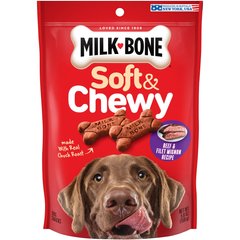12 Signs of Cancer in Dogs
SolStock/iStock/Getty Images Plus via Getty Images
Nobody likes to hear the word cancer, and unfortunately this disease is common in dogs, especially those of senior age. The signs of cancer in dogs can be subtle and easy to overlook, but pet parents can use this guide to learn what to look for.
Early detection and treatment of cancer in dogs is critical. By detecting cancer early, you and your veterinarian can determine a suitable treatment approach to increase the chance for cure or remission.
If you notice any unusual symptoms in your dog, consult your veterinarian as soon as possible.
12 Signs of Cancer in Dogs
Various signs a dog could have cancer range from subtle abnormalities to obvious symptoms.
It’s important to recognize that each dog may experience varying symptoms depending on the type of cancer they have, and that cancer symptoms in dogs are often subtle, especially early on.
The most common signs of cancer in a dog include:
1. Unexplained Weight Loss
-
Why it’s a concern: Sudden weight loss can be an early sign of cancer, especially in the digestive system.
-
What it may indicate: lymphoma, gastrointestinal tumors, oral melanoma, liver cancer
2. Changes in Appetite
-
Why it’s a concern: Increases or decreases in appetite can occur with various types of cancer.
-
What it may indicate: gastrointestinal tumors, lymphoma, oral melanoma
3. Gastrointestinal Upset
-
Why it’s a concern: Chronic vomiting or diarrhea could indicate underlying cancer, especially if it is accompanied by weight loss.
-
What it may indicate: gastrointestinal tumors, lymphoma, liver cancer
4. Lethargy
-
Why it’s a concern: Extreme lethargy may indicate underlying cancer because tumors take a lot of energy to grow. Blood cells may also be negatively impacted by cancer, resulting in lethargy.
-
What it may indicate: Lymphoma, osteosarcoma, hemangiosarcoma
5. Enlarged Lymph Nodes
-
Why it’s a concern: Swollen lymph nodes can occur directly as a result of cancer or due to metastasis (spread) of cancer throughout the body.
-
What it may indicate: Lymphoma, mast cell tumors, melanoma
6. Skin Lumps
-
Why it’s a concern: When dogs develop lumps on their skin, especially if they grow rapidly or are irregular in appearance or size, they should be checked for cancer.
-
What it may indicate: Soft tissue sarcoma, squamous cell carcinoma, mast cell tumor
7. Pain or Swelling
-
Why it’s a concern: Obvious signs of pain, such as limping or whimpering, could indicate an underlying health concern, such as cancer.
-
What it may indicate: Osteosarcoma, hemangiosarcoma, soft tissue sarcoma
8. Difficulty Breathing or Coughing
-
Why it’s a concern: Dogs may have difficulty breathing or experience frequent coughing episodes if a tumor is within or putting pressure on their airways.
-
What it may indicate: Lymphoma, lung cancer, hemangiosarcoma
9. Body Odor
-
Why it’s a concern: Dogs with cancer often have abnormal body odors, such as bad breath, due to tumors and the compounds they release in the body.
-
What it may indicate: Oral melanoma, skin cancer, anal sac adenocarcinoma
10. Abnormal Bleeding
-
Why it’s a concern: Some types of cancers interfere with or damage blood vessels, which can result in bleeding from the nose and mouth or internal bleeding.
-
What it may indicate: Hemangiosarcoma, oral cancer, lymphoma
11. Impaired Wound Healing
-
Why it’s a concern: Cancer can disrupt a dog’s normal immune function, thereby disrupting normal wound healing.
-
What it may indicate: Mast cell tumors, skin cancer, hemangiosarcoma
12. Urinary Changes
-
Why it’s a concern: Dogs with cancer of their urinary tracts could experience straining, inappropriate urination, bloody urine, or urinating more frequently.
-
What it may indicate: Transitional cell carcinoma, renal carcinoma
How To Help Detect Cancer in Dogs Early
Pet parents can take steps to help detect cancer early in their pets. Here are helpful tips:
Seek Regular Preventative Veterinary Care
One of the most important steps you can do to identify health problems, such as cancer, is to bring your pet to see a veterinarian for regular checkups. Any obvious abnormalities like skin lumps or concerning symptoms can be addressed.
Adult dogs should visit the veterinarian at least once per year, and senior dogs should be seen twice yearly.
Do Routine Bloodwork and Urinalysis
Be proactive about your dog’s health by agreeing to lab work, including blood work and a urinalysis, at your dog’s wellness checkups.
These are vital tests that give veterinarians insight into a dog’s overall health.
Inspect Their Tongue and Oral Cavity
Hold a yummy dog treat out and let your pet lick the treat while you visually inspect the top and bottom of their tongue.
Certain types of cancer, such as squamous cell carcinoma, can affect the tongue and other parts of the oral cavity.
Never reach your hands inside your dog’s mouth or try to pry it open to inspect, as this can be a bite risk.
Feel Their Skin and Coat
Gently rub your hands along your dog’s skin and coat to feel for any new lumps or bumps that have developed.
Take note of any wounds that don’t appear to be healing well.
Inspect Their Body, Face, and Paws
Identify if your pet has lost weight. Visually inspect your dog’s face and paws for obvious abnormalities, such as abnormal bleeding or wounds.
Feel Their Leg Bones and Joints
Gently run your hands down your dog’s leg to identify any obvious swelling or discomfort.
Osteosarcoma is a common bone cancer that affects dog legs.
Pay Attention To Subtle Changes in Your Dog’s Behavior
If your dog seems more tired than normal or their food bowl is left untouched, it could indicate an underlying issue that needs to be addressed.
Likewise, changes in urinary habits should not be ignored.
Dog Cancer Symptoms FAQs
What are the first signs of cancer in dogs?
Depending on the type of cancer, there may be very minimal early signs. Dogs may experience reduced appetite, vomiting, weight loss, or obvious lumps on their skin.
How can I tell if my dog’s lump is cancerous?
The only way to tell if a dog’s lump is cancerous is to schedule a veterinary checkup where a veterinarian will take a sample of the lump and view it under the microscope and possibly send it to a pathology lab.
Unfortunately, the appearance and the feeling of lumps does not determine whether they are benign or cancerous.
How common is cancer in dogs?
Cancer is very common in dogs, especially those of senior age. It is estimated that 25% of all dogs (and 50% of senior dogs) will develop cancer in their lives.
What is the most common cancer in dogs?
Several cancers are common in dogs, but lymphoma is one of the most prevalent.


